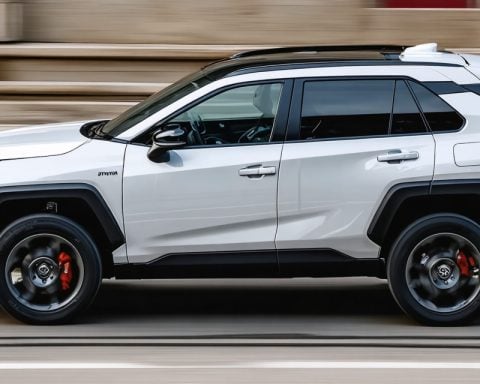Charging Up Electric Mobility in Ashford Borough
In a bold move towards eco-friendly transportation, Ashford Borough is enhancing its electric vehicle (EV) infrastructure with the recent installation of three new charging points at Vicarage Lane car park. This development marks a major milestone in the community’s commitment to sustainability and green technologies.
The installation is part of a larger initiative that has successfully introduced 29 charging points across nine car parks in both Ashford and Tenterden, boasting a total of 53 connections. With over 2,000 EVs registered locally, this infrastructure expansion caters significantly to the growing demand for reliable charging solutions. Users will benefit from a competitive rate of 39p per kilowatt hour.
Ambitiously, the local council aims for net zero carbon emissions in its operations by 2030, showcasing its dedication to environmental responsibility. Plans for additional charging stations are underway to ensure easy access for all electric vehicle owners.
Beyond infrastructure, community involvement is integral to this initiative. Residents are encouraged to provide input on future charging locations, making the process a collaborative effort toward a sustainable future.
As Ashford Borough continues to lead with its green transport initiatives, it sets a standard for other regions to follow, illustrating a significant shift in how communities engage with transportation and environmental sustainability. The future truly looks bright for electric mobility in the region!
Charging Ahead: The Broader Impact of Electric Mobility in Ashford Borough
The push for electric vehicle (EV) infrastructure in Ashford Borough reflects a growing trend that transcends local initiatives, influencing broader societal and economic dynamics. As communities invest in EV charging infrastructure, they contribute to a transformational shift in transportation modes, drastically reducing reliance on fossil fuels. This commitment not only aids in combating climate change but also fosters a culture of sustainability within the community, encouraging greener choices among residents.
On a global scale, the expansion of electric mobility infrastructure demonstrates the potential for economic revitalization. The shift towards EVs opens up significant job opportunities across various sectors, including manufacturing, installation, and maintenance of charging stations. As consumer demand for electric vehicles soars, regions that prioritize EV-friendly policies can attract investments and companies focused on sustainable technologies.
However, there are environmental considerations that this transition must address. The production and disposal of batteries, over time, may pose ecological challenges that communities need to manage proactively. Future trends will likely focus on improving battery recycling methods and sourcing materials sustainably to minimize ecological footprints.
Long-term, the ongoing enhancements in EV infrastructure like those in Ashford may serve as case studies, illustrating how collaborative approaches between local governments, communities, and businesses can effectively lead the way to a more sustainable future. As cities worldwide follow suit, the groundwork laid by such initiatives can significantly influence global efforts toward sustainable transit systems.
Transforming Transportation: How Ashford Borough is Leading the Charge in Electric Mobility
Charging Up Electric Mobility in Ashford Borough
In a bold move towards eco-friendly transportation, Ashford Borough is enhancing its electric vehicle (EV) infrastructure with the recent installation of three new charging points at Vicarage Lane car park. This development marks a major milestone in the community’s commitment to sustainability and green technologies.
The installation is part of a larger initiative that has successfully introduced 29 charging points across nine car parks in both Ashford and Tenterden, boasting a total of 53 connections. With over 2,000 EVs registered locally, this infrastructure expansion caters significantly to the growing demand for reliable charging solutions, with users benefitting from a competitive rate of 39p per kilowatt hour.
Pros and Cons of EV Charging in Ashford Borough
Pros:
– Environmental Impact: Reduces carbon emissions and promotes sustainable transportation options.
– Community Involvement: Residents contribute to the decision-making process regarding charging locations, fostering a sense of ownership.
– Accessibility: Increased availability of charging points encourages more residents to consider EVs.
Cons:
– Initial Costs: The installation and maintenance of EV charging infrastructure can be costly for local governments.
– Space Limitations: Finding suitable locations for new charging points may be challenging in densely populated areas.
– Dependence on Technology: As EVs become more prevalent, consistent upgrades may be needed to keep up with technology advancements.
FAQ about Electric Vehicle Charging in Ashford
Q: How much does it cost to charge an electric vehicle in Ashford?
A: The current rate for using charging points in the area is 39p per kilowatt hour.
Q: Where are the charging points located?
A: There are 29 charging points available across nine car parks in Ashford and Tenterden.
Q: How can residents suggest new charging station locations?
A: The local council encourages community input, providing channels for residents to propose and discuss potential new charging sites.
Features and Innovations
Ashford Borough is not only expanding its charging infrastructure but is also focusing on smart features that enhance user experience. Some key aspects include:
– Fast Charging Capabilities: New installations are designed to facilitate faster charging times, catering to the needs of busy EV owners.
– User-Friendly Payment Systems: Integration with mobile apps for real-time availability and seamless payment options.
Insights into Future Developments
The local council aims for net zero carbon emissions in its operations by 2030, showcasing a dedication to environmental responsibility. Ongoing plans for additional charging stations aim to ensure easy access for all electric vehicle owners, thus supporting Ashford’s overall sustainability goals.
Market Analysis of Electric Vehicle Adoption
With a sharp increase in the number of electric vehicles registered—over 2,000 as reported—Ashford Borough exemplifies a growing trend in EV adoption across the UK. As infrastructure expands and public awareness increases, the shift towards electric mobility is expected to accelerate, urging other towns and cities to follow suit.
Conclusion
As Ashford Borough moves forward with its green transport initiatives, it sets a leading standard for other regions to emulate, reflecting a significant change in community engagement with transportation and environmental sustainability. The future looks bright for electric mobility in the region, as ongoing developments promise to enrich the local EV community and contribute to global sustainability efforts.
For more information on electric vehicle initiatives, visit Ashford Borough Council.













